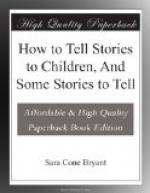Oh dear, yes! Dame Fairy Tale comes bearing a magic wand in her wrinkled old fingers, with one wave of which she summons up that very spirit of joy which it is our chief effort to invoke. She raps smartly on the door, and open sesames echo to every imagination. Her red-heeled shoes twinkle down an endless lane of adventures, and every real child’s footsteps quicken after. She is the natural, own great-grandmother of every child in the world, and her pocketfuls of treasures are his by right of inheritance. Shut her out, and you truly rob the children of something which is theirs; something marking their constant kinship with the race-children of the past, and adapted to their needs as it was to those of the generation of long ago! If there were no other criterion at all, it would be enough that the children love the fairy tale; we give them fairy stories, first, because they like them. But that by no means lessens the importance of the fact that fairy tales are also good for them.
How good? In various ways. First, perhaps, in their supreme power of presenting truth through the guise of images. This is the way the race-child took toward wisdom, and it is the way each child’s individual instinct takes, after him. Elemental truths of moral law and general types of human experience are presented in the fairy tale, in the poetry of their images, and although the child is aware only of the image at the time, the truth enters with it and becomes a part of his individual experience, to be recognised in its relations at a later stage. Every truth and type so given broadens and deepens the capacity of the child’s inner life, and adds an element to the store from which he draws his moral inferences.
The most familiar instance of a moral truth conveyed under a fairy-story image is probably the story of the pure-hearted and loving girl whose lips were touched with the wonderful power of dropping jewels with every spoken word, while her stepsister, whose heart was infested with malice and evil desires, let ugly toads fall from her mouth whenever she spoke. I mention the old tale because there is probably no one of my readers who has not heard it in childhood, and because there are undoubtedly many to whose mind it has often recurred in later life as a sadly perfect presentment of the fact that “out of the abundance of the heart the mouth speaketh.” That story has entered into the forming consciousness of many of us, with its implications of the inevitable result of visible evil from evil in the heart, and its revelation of the loathsomeness of evil itself.
And no less truly than this story has served to many as an embodiment of moral law has another household tale stood for a type of common experience. How much the poorer should we be, mentally, without our early prophecy of the “ugly ducklings” we are to meet later in life!—those awkward offspring of our little human duckyard who are mostly well kicked and buffeted about, for that very length




